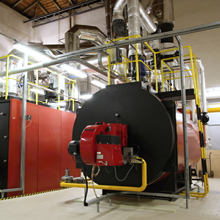

Mechanical Engineers: The Interior Designers of Equipment and Boiler Rooms
Posted by Eric Baluch on in Engineering
As mechanical engineers, we are frequently involved with boiler room equipment layouts. While fitting modern equipment into an antiquated space may challenging for some engineers, our firm rises to the challenge to create a design that is maintainable, serviceable, efficient and clean.
Much like furniture in a living room, each piece of equipment in a boiler room (including the boiler, expansion tank, pump, feed valve, and air separator) has a unique function and requires expert placement in order to operate properly. Furthermore, equipment operation is highly dependent on water temperature and pressure (there’s a different temperature and pressure at every point in the system), which is why the location of each piece of equipment is crucial in designing a successful hot water system.
The point of no pressure change: PNPC
PNPC in a heating hot water system is the location in the system where the water pressure cannot change. The pressure at this location is not dependent on the operation of the pumps or boilers. This location is wherever the expansion tank is connected to the system because the pump cannot add or remove water from the expansion tank. Water cannot be removed from an expansion tank by the pump and added to the system because water is an incompressible fluid. Hypothetically, if the pump were to remove water from the expansion tank and add it to the system, the pump would be compressing the water, which is impossible.
PNPC is important in a boiler system because it affects how the rest of the equipment will act on the water in the system. They can either lower the pressure on their suction side to create a pressure differential or they can increase their discharge side pressure to create the pressure differential needed to move the water.
How does the PNPC affect the boiler room design?
If a pump is placed so that the discharge side is pumping to the expansion tank (PNPC), the pump will lower the pressure on its suction side because it cannot change the pressure at the expansion tank. If this occurs, the system pressure can become so low that air will want to enter into the system any way that it can. A system with a lot of air dissolved in it can cause damage to components and piping, cause noise in the system, and require frequent bleeding of terminal equipment.
If a pump is placed so that it is pumping away from the expansion tank it will add its pressure differential to the discharge side of the pump, again, because it cannot change the pressure at the expansion tank. With a higher system pressure, air is less likely to enter the system and cause problems. With a low system pressure, air is more likely to get trapped at high points in the system, instead of staying dissolved in the water where it can later be removed by the air separator.
Other pieces of equipment in the design
We know that the pump cannot add or remove water to the expansion tank, but what can? The only way to add or remove water to the expansion tank is with a feed valve (make-up water assembly) or when the temperature in the system changes causing the water to expand or contract. A feed valve monitors the system pressure and opens whenever the system pressure drops below the feed valve’s set point at which point make-up water is allowed into the system.
In order for the feed valve to get an accurate reading, the only location a feed valve should be placed is right at the PNPC on the pipe connecting the expansion tank to the rest of the system. At this location, the feed valve will get an accurate reading of the system pressure that is not affected by the operation of the pumps, and the valve will only open whenever the system truly needs makeup water.
Placing the air separator
The air separator is responsible for removing air from the system and its location in the system can change how effectively it performs this task. Air is removed from water most easily whenever the air is in a gas form and not dissolved in the water. Water can keep more air dissolved in it when the water is at a low temperature and when the water is at a high pressure, so the best place to locate the air separator is at the location in the system with the highest temperature and the lowest pressure. That location in a boiler system is after the boiler (highest temperature) and before the pumps (lowest pressure).
Correct placement of each piece of equipment in a boiler system will ensure that equipment operates optimally, increases the effectiveness and lifespan of the equipment, and decreases the need for maintenance.
As mechanical engineers, boiler rooms are our hangouts – our living rooms – and we’d love to help make yours better. Send us a note and say hello!

 Previous STORY
Previous STORY